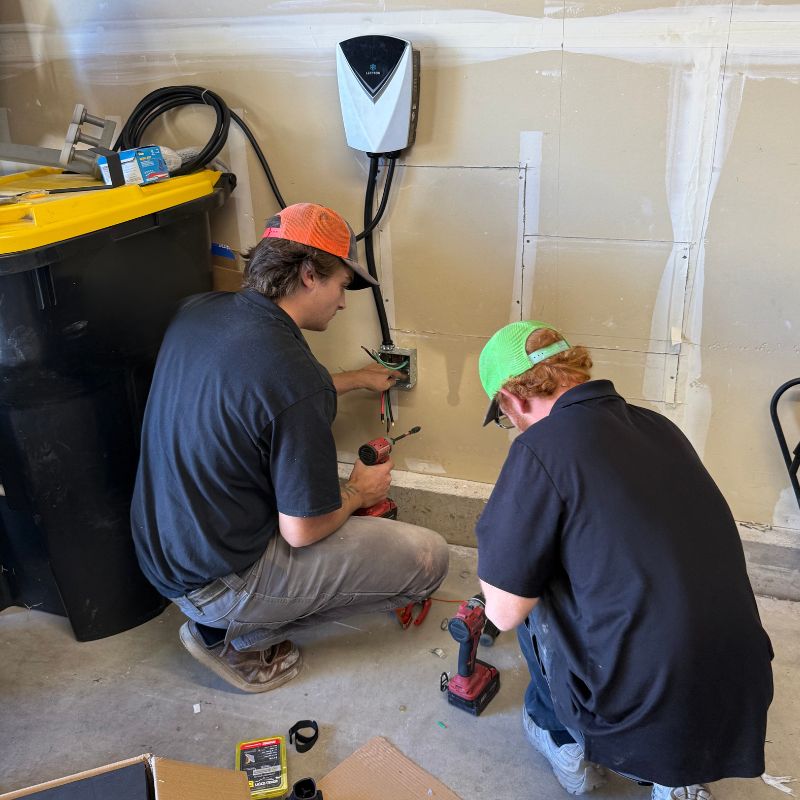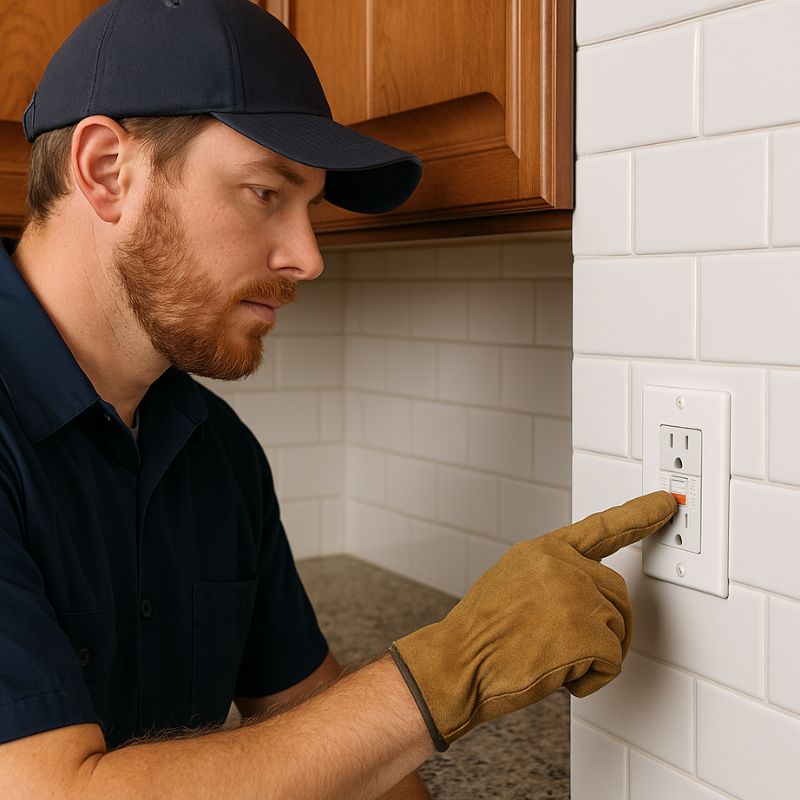Contents
- How to Install a Ceiling Fan without Existing Wiring: What You Need to Know
- Why Install a Ceiling Fan?
- Tools and Materials You’ll Need
- Step 1: Turn Off the Power
- Step 2: Choose the Fan Location
- Step 3: Install a Ceiling Fan-Rated Electrical Box
- Step 4: Run New Wiring to the Fan
- Step 5: Make the Wire Connections
- Step 6: Mount the Fan and Assemble
- Step 7: Restore Power and Test
- Bonus Tips from the Pros
- Common Questions About Ceiling Fan Installation
- The Easy Button: Call The Electricians
How to Install a Ceiling Fan without Existing Wiring: What You Need to Know
So, you want to install a ceiling fan in a room with no existing wiring? That’s like trying to hang a hammock where there are no trees, but don’t worry, we’ve got the blueprint.

Whether you’re trying to escape the summer heat or just reduce your reliance on central air conditioning, adding a ceiling fan is one of the smartest upgrades you can make.
Installing a ceiling fan without existing wiring isn’t just a matter of mounting the fan and flipping a switch. It involves running new wires, cutting into drywall, and knowing the difference between a black wire and a ground wire.
In other words, it’s not a job for the faint of heart, or the unlicensed DIYer.
Let’s walk through how the pros at The Electricians handle this project, step by step.
Why Install a Ceiling Fan?
There are many good reasons to install a ceiling fan, even if it means adding new wiring. These fixtures circulate warm air in the winter, cool air in the summer, and reduce your need for AC.
They’re also more energy-efficient than most people think. By simply circulating air, they help you maintain comfort with less reliance on your HVAC system.
Plus, if you’re strategic about placement and fan direction, ceiling fans can help lower your electricity costs all year long.
Tools and Materials You’ll Need
Before you begin, gather your materials:
- Ceiling fan-rated electrical box
- Voltage tester
- Drywall saw
- Drill
- Fish tape
- Romex cable (typically 14/3 or 12/3)
- Wire nuts
- Electrical tape
- Ceiling fan with light kit (if desired)
- Wire connectors
- Stud finder
- Mounting bracket and fan blades
Step 1: Turn Off the Power
Before anything else, head to your breaker box and turn off the power to the room. This step is non-negotiable. Flipping a wall switch is not enough, you need to kill power at the circuit breakers to avoid the risk of shock.
Use a voltage tester to confirm there’s no power flowing to the wires you’ll be working with. If you’re not sure which breaker controls the room, flip them one at a time until you’re sure.
Step 2: Choose the Fan Location
You’ll want to install the fan near the center of the ceiling for the best airflow.
Use a tape measure and mark the center of the room. Then use a stud finder to locate the nearest ceiling joist. The ceiling fan box must be securely attached to a joist or supported by a fan-rated brace between two joists.
This isn’t just about convenience, improper mounting can cause the fan to shake, wobble, or fall. And no one wants fan blades flying across the room like ninja stars.

Step 3: Install a Ceiling Fan-Rated Electrical Box
Now it’s time to cut a hole for your electrical box. Trace the outline of the box onto the ceiling, then use a drywall saw to cut it out. Depending on your setup, you’ll either:
- Mount directly to a ceiling joist using screws, or
- Use a brace kit that expands between two joists and locks the box in place
Make sure the box is rated for fan installation. A regular light fixture box won’t cut it, a ceiling fan requires more support due to its weight and movement.
Step 4: Run New Wiring to the Fan
With no wiring in place, you’ll need to run new wires from a nearby power source, either an outlet or a switch.
This typically means drilling through studs and joists, fishing cable through the walls, and pulling it to the new ceiling fan location using fish tape.
You’ll likely be running three wires:
- Black wire: for fan power
- White wire: for neutral
- Ground wire: usually green or bare copper
- (Optional) Red wire: if your fan has a separate light kit and you’re installing a dual wall switch
This is also the time to install a new wall switch if you want one to control the fan and/or light separately.
Step 5: Make the Wire Connections
At the ceiling fan box, it’s time to make the wire connections. Use wire connectors or wire nuts to secure the wires together:
- Black wire to the fan’s black (or motor) wire
- White wire to white wire
- Ground wire to the green grounding wire on the fan or box
- Red wire to the light kit if applicable
Once you’ve made the connections, wrap each with electrical tape to ensure everything stays secure and safe.
Tuck the wires neatly into the box. It’s like electrical origami, tight, clean, and no room for mistakes.
Step 6: Mount the Fan and Assemble
Now you’re ready to hang the fan. Follow the manufacturer’s instructions to install the mounting bracket and motor housing.
Once the fan motor is in place, attach the fan blades. Make sure each one is secured tightly and evenly spaced to avoid wobbling.
If your fan includes a light kit, connect the necessary wires and attach the fixture to the fan.
Use the provided hardware to hang the fan from the bracket. This may require aligning the notches or slots to lock it into place.
Once mounted, give it a gentle push, there should be no rocking or give.
Step 7: Restore Power and Test
With everything in place, head back to the breaker box and restore power to the circuit. Then flip the wall switch and test the fan.
- Does the fan spin?
- Is the light kit working?
- Is it balanced and quiet?
If the fan wobbles or makes noise, double-check that all screws are tightened and that the blades are properly aligned.
Bonus Tips from the Pros
- Use a remote control: If you can’t run wiring for a wall switch, many ceiling fans can be operated via remote or Bluetooth.
- Check local codes: Some municipalities in Colorado require permits for this kind of electrical work.
- Upgrade the switch: If your fan includes a light kit, consider a dual-function light switch to control the fan and light separately.
- Call an electrician: If this all sounds a bit overwhelming, we can help. The Electricians are licensed, experienced, and fast.
Common Questions About Ceiling Fan Installation
Can I install a ceiling fan where there’s no light fixture?
Yes, but it involves running new electrical lines and installing a ceiling fan-rated box. This is a more complex job than simply replacing an existing fixture.
Do I need to mount the fan to a ceiling joist?
Absolutely. Ceiling joists provide the structural support needed to safely hang the fan. If the fan is placed between joists, a fan brace can be used instead.
What if I don’t have attic access?
No attic? No problem. Electricians can still run wiring using flexible drill bits and fish tape through walls and ceilings without attic access, it just requires more precision.

Should I use electrical tape and wire nuts?
Yes, both are essential for safe, long-lasting wire connections. Wire nuts secure the wires mechanically, and electrical tape provides extra insulation and peace of mind.
The Easy Button: Call The Electricians
Let’s be real, installing a ceiling fan without existing wiring is not your average weekend DIY. You’re dealing with high-voltage wiring, circuit breakers, drywall cutting, and code compliance.
One small mistake could trip your breaker or worse.
At The Electricians, we make fan installation simple, safe, and code-compliant.
Whether you’re upgrading your living room or adding airflow to a new office space, we’ll take care of everything from wiring to mounting.
Ready to stay cool and save energy? Contact us today or explore our Ceiling Fan Installation Services for expert help.
Related Posts
If you enjoyed reading this, then please explore our other articles below:








